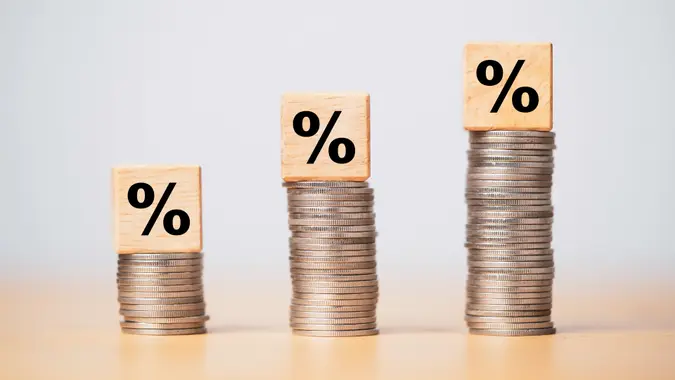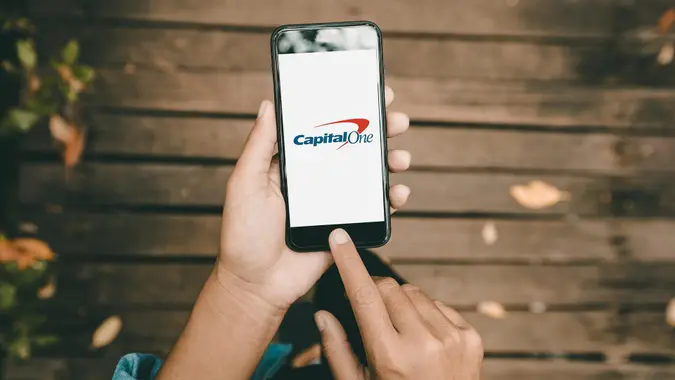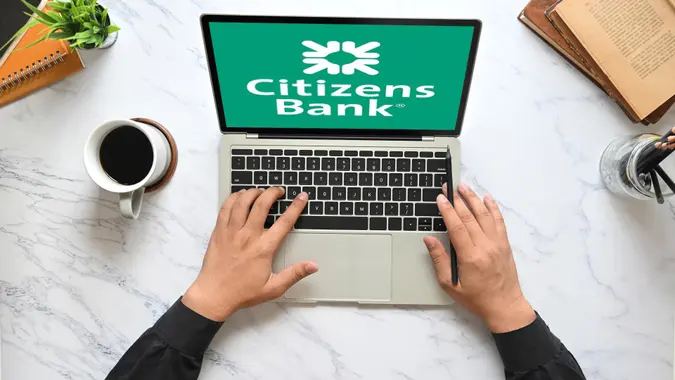The Pros and Cons of High-Yield Savings Accounts

Commitment to Our Readers
GOBankingRates' editorial team is committed to bringing you unbiased reviews and information. We use data-driven methodologies to evaluate financial products and services - our reviews and ratings are not influenced by advertisers. You can read more about our editorial guidelines and our products and services review methodology.

20 Years
Helping You Live Richer

Reviewed
by Experts

Trusted by
Millions of Readers
A high-yield savings account offers a safe place to store your cash with a key benefit: a higher interest rate. That means your savings can grow faster than in a traditional savings account. Although interest rates have come down a bit from their roaring highs of 2023 and early 2024, many high-yield savings accounts still pay annual percentage yields above 4%.
Before you open a new account, learn more about how these accounts work, including the pros and cons of high-yield savings accounts.
Pros of a High-Yield Savings Account
Higher Interest Rates and Earnings
High-yield savings accounts stand out for their APYs, which are typically much more generous than those you’d find with a traditional savings account.
The best high-yield savings accounts of 2025 offer APYs of around 4.50%, while the national average rate for savings accounts sits at a meager 0.41% as of March 17, 2025, according to FDIC data. This difference can significantly impact your earnings, especially over longer periods.
For example, say you deposit $10,000 into a traditional savings account that pays a 0.41% interest rate. After one year, you’ll have earned $41 in interest. However, if you deposit that same amount in a high-yield savings account that offers 4.50% APY, you’ll have earned $450. After five years, the traditional savings account will have paid about $210 in interest, while a deposit in the high-yield savings account will have earned about $2,460.
Safety and Security
A high-yield savings account is one of the safest places you can store your money. As long as the account is held at a federally insured institution, your funds are protected for up to $250,000 per depositor. If the bank fails, FDIC or NCUA insurance will reimburse you.
While high-yield savings accounts may not offer the potential returns of investments such as stocks or cryptocurrency, they come with a much lower risk. As long as your balance doesn’t exceed FDIC coverage limits, you won’t lose money in a high-yield savings account.
Easy Accessibility and Low Maintenance
Few high-yield savings accounts can match the convenience and immediate access to funds you’ll find with a checking account. However, high-yield savings accounts are much more liquid than certificates of deposit, and they often offer similar interest rates.
You can typically withdraw or transfer funds from your high-yield savings account relatively quickly and easily, and you don’t have to worry about early withdrawal penalties like you would if your money were locked up in a CD.
Another appealing feature of high-yield savings accounts is that you can find options with no maintenance fees or minimums. You can often open an account with no minimum deposit, and you may not have to maintain a minimum balance. Some banks may require you to keep your balance above a certain threshold to earn the top APY. You’ll likely want to consider all of these factors when choosing the right savings account for you.
Cons of a High-Yield Savings Account
There may be some cons to consider as well. See if these could apply to you.
Limited Access to Funds
While it’s true that high-yield savings accounts are more liquid than CDs — in other words, they offer greater flexibility in terms of penalty-free withdrawals. However, many come with restrictions that limit how often you can transfer or withdraw funds. A common limit is six transfers or withdrawals per month, and banks may charge a fee for any additional transactions.
Another limiting factor is that many high-yield savings accounts don’t come with ATM cards, so you may have to wait longer for transfers to be processed.
Variable Interest Rates
The interest rates tied to a high-yield savings account fluctuate based on market conditions. As interest rates rise, you might appreciate the ability to continue tapping into higher interest rates. In a falling interest rate environment, you may wish you’d locked in a higher rate by opening a CD instead.
Either way, the uncertainty can make it difficult to anticipate future earnings on your savings.
Online-Only Account Drawbacks
Many of the highest-yielding savings accounts these days are offered by online banks. This is largely because these banks aren’t burdened with the costs of operating physical branches, and they’re able to pass some of the savings on to customers in the form of higher rates.
Many online banks have robust apps and websites that provide user-friendly services, but most don’t have any branches available for in-person banking. They also may have limited customer service hours over the phone. This can potentially be a challenge if you need help with a more complicated or urgent transaction.
Advantages vs. Disadvantages: A Comparative Analysis
Here’s a quick snapshot of the pros and cons of a high-yield savings account:
| Pros | Cons |
|---|---|
| Higher rates | Withdrawal restrictions |
| Low risk | Fluctuating interest rates |
| Access to funds | Often no physical branches |
| Low or no fees and minimums | May not offer an ATM card |
When deciding whether to open a high-yield savings account, you’ll likely want to consider several key advantages and disadvantages.
Advantages
High-yield savings accounts offer several appealing advantages. They pay higher interest rates than traditional savings accounts and checking accounts, allowing your funds to grow faster. There is also very little risk of losing your money, and you can easily find accounts that don’t require a minimum balance or charge monthly fees. Plus, you can access the funds relatively quickly without penalty.
Disadvantages
However, there are some disadvantages to high-yield savings accounts as well. Many accounts limit the number of withdrawals or transfers you can make each month, and they may charge a fee for excess transactions.
Also, interest rates fluctuate, so you can’t count on continuing to earn the same APY that was offered when you opened the account. Finally, most of the top high-yield savings accounts are from online banks, so you’ll need to be comfortable without banking at a branch.
Who Should Consider a High-Yield Savings Account?
It can be worth having your money in a high-yield savings account if it will help with your financial goals. As long as you’re comfortable using mobile banking apps and don’t need to visit a physical branch, you can let your money earn more interest and boost your balance. These accounts are easily accessible, so you don’t have to completely give up your ability to earn interest on your funds.
A high-yield savings account can be a good place to set aside money for short-term and mid-range financial goals. You can use it to build your emergency fund, save for a vacation, or pay for a big-ticket item like a down payment on a car or a new roof.
If you don’t need flexible access to the funds and want to lock in higher interest rates, other financial products might be a better fit. For example, you might opt for a CD to tuck away funds in a low-risk way. Or, if you are saving for a long-term goal, like retirement, you might choose to work with a financial advisor to build an investment portfolio instead.
Potential Hidden Fees and Costs
High-yield savings accounts don’t typically hit you with a lot of fees, but there are a few potential costs to be aware of before you choose an account.
- Maintenance fee: Some high-yield savings accounts charge a monthly fee. This fee rarely exceeds $10 and can usually be waived if you maintain a certain minimum balance.
- Excess transaction fee: Many high-yield savings accounts restrict you to a limited number of monthly withdrawals or transfers, which is often around six, and they may charge you a fee if you go over the maximum. If you plan to dip into your high-yield savings account frequently, you’ll want to be familiar with these limits.
- Overdraft fee: If you make a withdrawal or request a transfer that drops your account balance below zero, you may be hit with an overdraft penalty. This fee is typically around $35, so it is one to avoid if possible.
Top High-Yield Savings Account Providers and What They Offer
With thousands of banks and credit unions to choose from nationwide, comparing high-yield savings accounts from each would be quite the cumbersome task. You may want to start by looking at the best banks for savings accounts in 2025. Here’s a look at a handful of the top banks offering high-yield savings accounts and the benefits they provide.
EverBank Performance Savings
- APY:
- Top features: No maintenance fee, no minimums, APY applies to all balances
Bask Bank Interest Savings Account
- APY:
- Top features: No maintenance fee, no minimums, strong app ratings
Jenius Bank Savings Account
- APY:
- Top features: No maintenance or excess transaction fee, easy withdrawals, 24/7 phone support
BrioDirect High-Yield Savings Account
- APY:
- Top features: High APY, no maintenance fee
Popular Direct Select Savings
- APY:
- Top features: High APY, low minimum deposit of $100
This chart offers an at-a-glance view of some of the high-yield savings accounts highlighted above.
MOST COMPARABLE
MOST COMPARABLE
MOST COMPARABLE
Fees
Fees
Fees
No monthly maintenance fees
No monthly maintenance account fee
None
APY
APY
APY
Min Opening
Min Opening
Min Opening
$0
$0
$0
Tips for Maximizing Your High-Yield Savings Account
Getting the most out of your high-yield savings account requires more than simply finding the top interest rate and depositing some cash. It can pay off to follow some of these tips for effectively managing the money in your account.
Set Up Automated Transfers or Deposits
Continuing to add to your savings will allow you to take advantage of that high APY and allow your funds to grow more quickly. A great way to ensure you keep saving is to set up automated transfers from your checking account or deposits from your paycheck, if possible.
Set Savings Goals
When you open your account, lay out a target amount of savings you’d like to reach. Consider using the account for a specific purpose, such as an emergency fund or paying for a home project.
Pay Attention to Balance Requirements
Some banks require you to maintain a minimum balance to earn the top advertised APY. Others may put a cap on the balance that can earn the highest rate. Make sure your balance stays in the sweet spot where it’s earning the maximum returns possible.
Avoid Fees
Why open a new savings account with a higher interest rate just to have unnecessary fees chip away at your gains? Try to find a high-yield savings account that doesn’t charge a monthly fee, and be aware of any fees that might come with falling below a balance requirement or making too many withdrawals.
Common Myths About High-Yield Savings Accounts
Have you heard these myths before? See why some of them might not hold up.
Myth 1: The Interest Rate Stays the Same
When you open a savings account with a 4.50% APY, it’s easy to let yourself begin calculating future returns from that great rate. However, interest rates on high-yield savings accounts fluctuate, sometimes as frequently as every month, and those changes can be significant if market conditions move substantially.
Myth 2: You Can’t Access Your Money
Withdrawing from a high-yield savings account is quite simple. It might not be as instant as inserting your card into an ATM, but you’ll still have plenty of flexibility when it comes to accessing your money. For example, you can log into your online account and request a transfer or withdrawal in just a few minutes. You’ll usually receive your funds within a day or two, depending on your bank. That is much better access than if your money were locked into a CD.
Myth 3: You Don’t Actually Earn That Much
Some will argue that the returns on a high-yield savings account aren’t worth the effort. Whether the earnings are worth it depends largely on each person’s individual goals. However, the returns on high-yield savings accounts can be substantial when compared to keeping your money in a traditional savings account. Many of the top accounts offer APYs that are 10 times the national savings average.
Alternatives to High-Yield Savings Accounts
While high-yield savings accounts (HYSAs) are a popular option for growing your cash with minimal risk, they’re not the only place to park your money. Depending on your goals — whether it’s liquidity, guaranteed returns, or higher yield — other financial products may offer a better fit.
- Certificates of Deposit (CDs): Higher fixed rates, but funds are locked in for a set term with penalties for early withdrawal.
- Money Market Accounts: Similar to savings accounts but may offer check-writing and debit access with slightly lower yields.
- High-Yield Checking Accounts: Competitive interest rates, but require monthly activity like debit card use or direct deposits.
- Treasury Bills or Bond Funds: Low-risk investments with solid returns; Treasuries are government-backed and tax-advantaged.
- Cash Management Accounts: Fintech hybrid accounts that earn interest on idle cash and offer flexible spending features.
A high-yield savings account is great for emergency funds and short-term savings, but exploring alternatives could help you earn more — or find a better fit based on how and when you plan to use your money.
If you’re keeping money in a savings account — and you should be — it makes sense to let that money earn as much as it can. A high-yield savings account may be the right solution for you. However, the interest rate isn’t the only feature to consider.
Before opening an account, shop around to find the one with the combination of features and interest rate that will meet your financial needs. Pay attention to the fine print to make sure you understand your account limits, especially if the bank offers tiered interest rates.
FAQs on the Pros and Cons of High-Yield Savings Accounts
Here are more answers to your questions about savings accounts.- Is it better to invest or have high-yield savings?
- Investment products and high-yield savings accounts serve different purposes, and what's right for you depends on several factors. A high-yield savings account is a good option for an emergency fund that you can quickly tap when you need to cover an emergency or surprise expense. The higher interest rate means your money can earn more than it would in a traditional savings account, and the account should come with FDIC protection, so you can't lose your money.
- Investment products typically come with higher degrees of risk and lower levels of liquidity. The average return for the S&P 500 was around 9% between 1996 and 2022. That's nearly double the return offered by a high-yield savings account. If you prefer a lower-risk investment, certificates of deposit also offer a higher rate than you get in a savings account. For example, Marcus by Goldman Sachs pays 3.65% APY on its high-yield savings account, but you can earn an APY of 4.20% for a 12-month CD. The trade-off is that your portfolio can lose money in a sluggish stock market, and you'll pay penalty fees if you need to cash in your CD early.
- Is it hard to take money out of a high-yield savings account?
- In most cases, taking money out of a high-yield savings account is no harder than taking money out of a traditional savings account. Since many of these accounts are offered through online banks, you'll do most of your banking through a website or mobile app. You should be able to transfer money from the high-yield savings to a linked checking account, initiate a wire transfer, or request a paper check. Before withdrawing money from any savings account, note the number of withdrawals you're allowed to make each month. Some banks still impose a six withdrawal per month limit and will charge you if you exceed it, while others have no restrictions
- Can you get a 7% interest savings account?
- No bank or credit union is currently offering 7% interest for a high-yield savings account. You can find many banks with generous APYs, such as the ones on the list above. If you don't need immediate access to your money, consider a high-yield CD. You can get an APY of 4.25% on a 12-month CD from Forbright.
Allison Hache and Sarah Sharkey contributed to the reporting for this article.
Rates are subject to change; unless otherwise noted, rates are updated periodically.
 Written by
Written by  Edited by
Edited by 




























